Fermented cornmeal is a delicious way to improve the nutritional value of this hard-to-digest grain. Though there are technical differences between polenta and cornmeal (including the culture of origin, method of preparation, and serving style) in terms of fermentation they are pretty much the same.
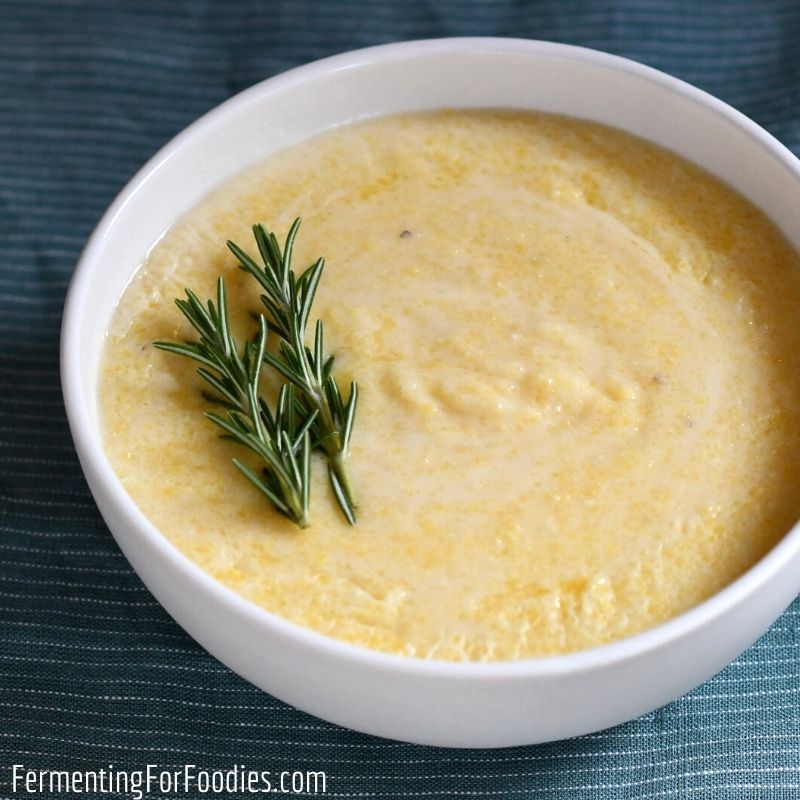
Why Ferment Corn?
Due to its high cellulose content, corn is very difficult to digest. Thus, it is hard to absorb nutrients from cornmeal. This is why the Aztec and Mayan civilizations developed nixtamalization, a process that uses lime to break down maize for making masa flour.
Fermenting provides a lot of the same benefits. Here are a few reasons to make fermented cornmeal:
- It adds a delicious flavor dimension to cornbread, grits, and polenta.
- Reduces the aflatoxins from contaminated corn (a carcinogen produced by fungus on foods.)
- Breaks down the cornmeal so that the nutrients are more easily absorbed.
- It’s easy! Corn ferments really well when combined with a lactic bacterial culture.
Cooking fermented cornmeal
This recipe for fermented cornmeal can be used for all sorts of different polenta and cornmeal-based dishes. Here’s how to adjust the recipe to work with whatever you are planning to cook:
- Grits: For simple southern style grits, replace 1 cup of water in the cooking instructions with 1 cup of milk. Add 1/4 cup of butter, 2 cups of grated cheese, and 1/2 cup of chopped spring onion.
- Firm polenta: Replace the 2 cups of water with 1 cup of broth for cooking and reduce the salt, to taste (about 1/2 tsp).
- Cornmeal Porridge: Cook with 2 cups of water for really soft cornmeal, that has a porridge-like consistency.
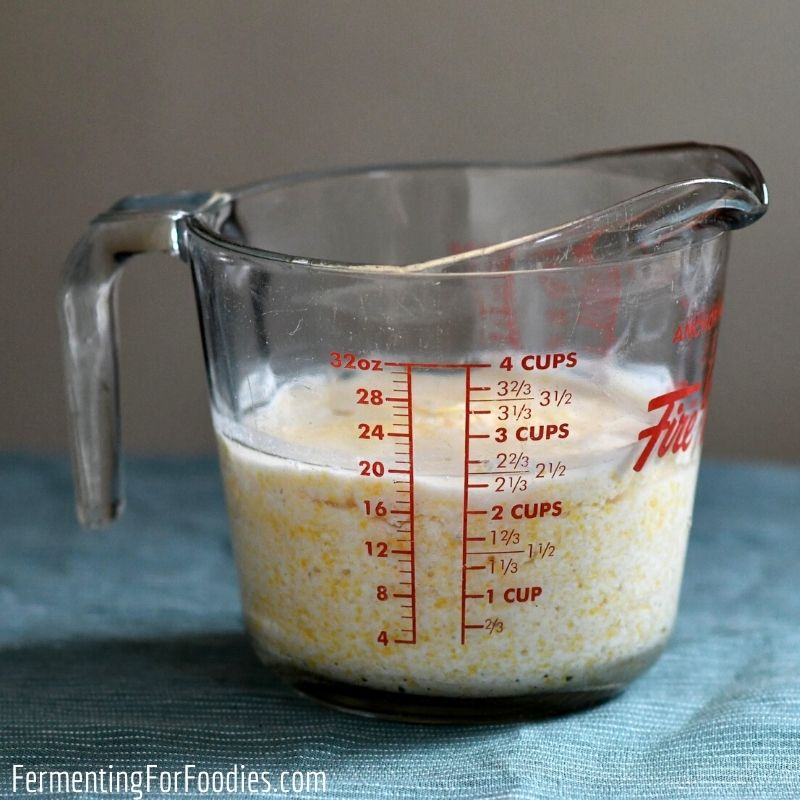
Simple Fermented Cornmeal or Polenta
Here’s how to prepare fermented cornmeal or polenta. The recipe is the same regardless of what type of ground corn you are using. Fermented cornmeal can be used to make cornbread, grits, or Italian polenta. See the sections above for more details.
- Prep Time: 5 minutes
- Cook Time: 30 minutes
- Total Time: 35 minutes
- Yield: Serves 6-8 1x
- Category: Side Dish
- Method: Fermented
- Cuisine: Traditional
- Diet: Gluten Free
Ingredients
Fermenting
- 1 cup cornmeal (coarse, medium, or fine)
- 2 cups of filtered water
- 2 Tbsp lactic culture (see notes)
Cooking
- 2 cups water
- 1 tsp salt, to taste
Instructions
- Mix the cornmeal with the water and culture in a large glass measuring cup or bowl.
- Cover the container with a tea towel and leave it to ferment for 12-24 hours on the kitchen counter.
- When you are ready to cook the cornmeal, scrape the soaked cornmeal and any additional fermenting liquid into a saucepan.
- Add in the additional water, bring to a boil and simmer for 20 minutes. Stir frequently, until the cornmeal is soft and the liquid is gone.
Notes
- Cornmeal breaks down best with a lactic culture. Use yogurt, buttermilk, kefir, or whey. For a vegan option, use vegan yogurt or fermented vegetable brine.
- Feel free to change the liquid to suit your recipe. See the section above for turning this recipe into a firm polenta or soft, creamy grits.
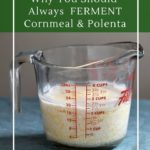
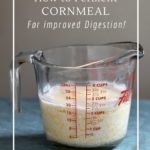
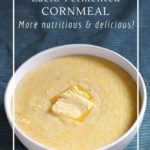
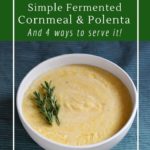
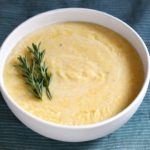
Hello Emillie, thanks for this, I want to make a gluten free bread with fermented grains. Your instructions are very helpful. Thank you. I am will try doing this with millet and sorghum grain. Like fermented teff, I could make flat breads and scones, muffins with fermented grain flour. Thank you again skaii ellen
Let me know how that goes! I have done millet, but never fermented sorghum. And if you eat flour, I have a bunch of GF sourdough bread recipes too.
Would milk kefir also work as the starter culture?
Yes!!! Buttermilk is just traditional.
Could you also just use apple cider vinegar?
You could! Or kombucha, sauerkraut juice, etc. I used dairy because that is traditional. 🙂
Would it be possible to make without cooking,only fermenting,and preserve the beneficial bacteria?
Corn is really hard to digest, so I recommend cooking it. Pre-fermenting helps improve the digestibility of corn, similar to using lime in masa flour, but it still needs to be cooked. If you wanted probiotic grits, I recommend cooking then fermenting afterwards. You would end up with a porridge-like consistency. Let me know if it works for you!
Thank you so much,Emillie,I did it!First I cooked cornmeal,and after it cooled down to a room temperature,I added 2-3 spoons of fermented milk in it.Next day I tried it,and it was simply delicious!And I’m sure it’s healthy too…
Glad it worked! You’ve inspired me, I’m going to try it too!
Have you tried this with Bob’s Red Mill whole grain cornmeal? I find it a little bit coarse and grainy when I used it for cornbread, but I’m a sucker for “whole grain” labels. I’m tempted to try with a finer grain, as I think that will appeal to the younger palates more. I don’t mind it grainy for myself, but the rest of the family seems to object.
I haven’t tried that brand, though it should work well, likely better than it did for cornbread. I think most cornmeal is “wholegrain”, but it doesn’t have to be a coarse grind. Maybe try an instant polenta, which is basically finely ground cornmeal.
After researching this topic I am wondering why you suggest an acid base for this process rather than lime water which I’ve read is alkaline and what was used by the earliest methods?
You are right, the use of lime is traditional for masa (corn tortillas). I have a post on that as well. However, lime (not the fruit but the material) is quite caustic. It’s also not a form of fermentation, but rather a chemical breakdown.
Soaking cornmeal in an acid breakdowns it down in a different way.
Can this fermentation be done with “instant polenta”?
Yes! However, it won’t work with those packages of already cooked polenta.
Hello, I recently fermented oatmeal to make sowans and (used all the oats and Bran) in recipes. I am using the probiotic liquid as an acid to soak oats.
Would the leftover corn water, if enough extra was used to soak the cornmeal be a probiotic liquid too? I have been wanting to buy corn from a local source and am interested in your method. Thankyou for your post!
I have never heard of sowans before reading your comment. Had to look it up. Thanks for sharing! Sowans sounds very similar to Ogi (made with fermented millet and similarly turns into a gelled porridge). I haven’t tried soaking extra corn water as the corn always seems to soak it all up! But perhaps if you doubled the liquid it might work. If you try it, let me know how it works out!
I recently saw a recipe for vegan yogurt made using chickpeas and water…nothing else. The starter liquid was a small amount of the water that the dried chickpeas were soaked in. What is in that starter water?! I’m betting, having seen some of your posts, that you are the person to ask.
That does sound strange… soaking dried chickpeas in water is needed simply to cook them! I wonder if they were making aquafaba (leftover water from cooking chickpeas). Alternatively, they could have been trying to sprout the chickpeas to make a rejuvelac-style beverage. So that could have been the starter liquid… Not sure. Sorry!
I tried blue cornmeal with yogurt, and it didn’t ferment. Any idea what the issue might be? Does it need heat additionally? Or does blue corn just not work the way yellow does?
Hi Zena, I have personally used blue cornmeal, but I don’t know why it would be different. I’m wondering how you decided whether it is fermented? Yogurt doesn’t contain yeast, so it won’t bubble. However, it should still sour the cornmeal. My other thought is that yogurt typically cultures at warm temperatures, so if your house is cold it might have slowed down the ferment. Try cooking it and see if it has a soured flavor. Cheers!
does the cornmeal increase in size while fermenting?
It will absorb the liquid. So I think that’s yes? Depending on what you used for the culture, there may also be air bubbles in the mixture. Cheers!
Hello Emillie,
Do you know of any company that specializes in grain fermentation?
Are you meaning for people to eat at home? Officially, every brewery specializes in grain fermentation. 😉 However, I don’t believe there are any fermented grains available in my local grocery store beyond the usual sourdough bread and pasta. Cheers!
Hi Emillie,
You can find fermented corn dough in your local African market.
They tend to be frozen. Just ask the sales clerk or owner and they will point you in the right direction.
Interesting! I’ll have to look for that. Thanks for sharing!
I just made the polenta for the first time. It took 5 days before I could detect any sour smell with my home made red onion pickle juice in warm weather. No pink hue unfortunately.
Cooked on the sixth day and tasted more interesting than plain old polenta. Next time I’ll use a lactic culture to see whether it takes less time. Thanks for another addition to my fermented food recipe folder. My gut bacteria must be happy too!
Great! So excited you enjoyed this.